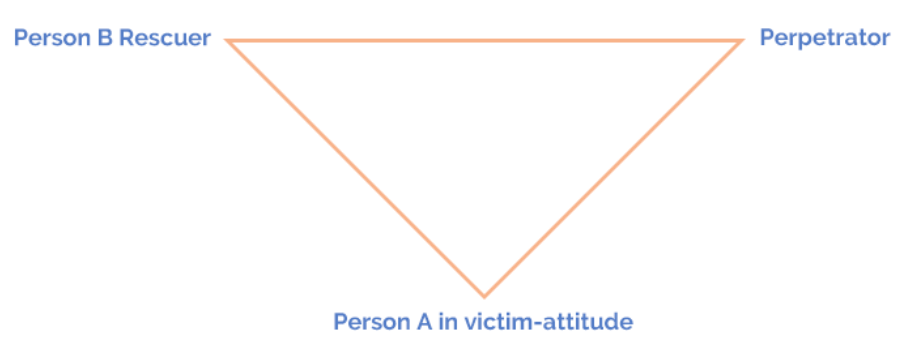|
The Drama Triangle, familiar to many, developed by Stephen Karpman, is Transactional-Analysis model. It describes what can happen in an interaction between two people. More of that a bit later after considering a few questions:-
How about your clients?
These are all survival parts in response to the developmental trauma that shapes us during our very early life and relationships. The rescuer is seeking love, acceptance, acknowledgement or inclusion; however, the strategy fails as it creates a survival relationship. Those who take up a victim-attitude are demonstrating a survival response from having been actual victims in the past when they had nowhere to turn and were powerless. An actual victim feels the terror, rage and humiliation of being treated in that way. A victim-attitude is an avoidance of taking responsibility for oneself as an adult, when we have different resources available, and where there is no actual danger to life. The feeling associated with victim attitude is a helplessness, loss of contact with a sense of self-agency but without the trauma feelings of being attacked. It has more of a whining tone. It is an uncomfortable part to be caught in, and it is important to understand the its roots. The snapper, the part who turns on others, is a perpetrator part; also an element of trauma survival dynamics. We attack from irritation, from competitiveness, from seeing the other as an object not as a person. How we might have been treated as children some of the time. In trauma survival, the victim-attitude and perpetrator parts are on either side of a pendulum, and we can swing from one to the other. One minute we feel helpless and look for a rescuer (of which there are often many to choose from) entangling them in our psyche dynamics, the next we can be berating that rescuer for being unhelpful, uncaring, and assuming a place of grandiosity in relation to them. Underlying this behaviour are feelings of fear, heightened anxiety, and vulnerability. Similarly, the rescuer can switch into the victim-attitude or to the perpetrator, attacking the victim they have decided to help, or talking badly about them to others. At no time do many of those involved see what their part of the entanglement is. An entanglement is when survival strategies come together in relationship, and do a dance from which there is no escape, in a misguided attempt to meet unfulfilled hopes and needs from the past. Understanding Professor Franz Ruppert’s, Split in the Psyche Model (see other blogs and my book Coaching and Trauma) helps place these survival parts within the survival self, stimulated through unconscious feelings from the ‘there and then’ being enacted in the ‘here and now’ due to subtle triggers in the environment. Now, back to the Drama Triangle. Many coaches will have introduced this to their clients with great effect as it brings these dynamics to the fore where they can be talked about and explored, as can the client’s part in them. Karpman didn’t develop the Drama Triangle to illuminate trauma dynamics, and to read fully what is behind the model and how it is used in Transactional Analysis see his website https://karpmandramatriangle.com/ However, we can adapt it to being trauma-informed. The ‘game’, using TA language, starts with Person A in victim attitude. They seek a rescuer and find Person B who is willing to ‘play’. Here the entanglement starts. Person A, expresses how over-worked they are, or how bad their life/work is, and Person B steps in to help or to do something they hope with rescue person A from those feelings and situation. But in so doing, they don’t realise the entanglement dynamic is not resolvable in that way, only keeps it going. Person A may feel a bit superior or ‘good’ about helping, they may also hope that it will get them some ‘love’ or recognition. Because it is a ‘game’ or a survival dynamic, at some point the process shifts. Usually Person A, in victim attitude, switches to be the perpetrator, accusing Person B of being unhelpful, bossy or generally making things worse. Thereby, Person A has shifted from being in Victim Attitude to being a Perpetrator, and Person B shifts into being an actual victim of person A’s attack. If they get stuck in victim attitude they might then go and see if they can find a rescuer and so on. Or Person B, in rescuer, might get fed up with the stuckness of Person A, and switch to perpetrator themselves, making Person A an actual victim of their attack and reinforcing old trauma memory pathways. Alternatively, Person A in victim-attitude may unconsciously look for Perpetrator to save them, which will not work out well for them. To protect themselves they may switch to rescuer in the illusion that they can ‘help’ the perpetrator be a nicer person. The ‘way out’ in TA terms is for one of the pair to step into the adult ego state, (as in Parent, Adult, Child ego states) and to observe the dynamics, to take responsibility for their part in it, and move away from rescuing or being in victim attitude. In trauma-informed coaching the way out is similar, to see the entanglement for what it is a misplaced desire for love, attention, retribution, to take responsibility for their own part and to use the resources in their healthy self to consider what is a better way to relate to this other person. How can they do that without inviting the other into, or stepping into, and entanglement? Using both Ruppert’s model and the Drama Triangle with clients (or ourselves) can be useful if we understand both fully and are skilled at introducing them into the coaching. Jules Vaughan Smith See my book ‘Coaching and Trauma: from surviving to thriving” published by Open University Press
Reading Franz Ruppert Trauma, fear and love Green Balloon Books
0 Comments
Your comment will be posted after it is approved.
Leave a Reply. |
News blogArchives
May 2024
Access Octomono Masonry Settings
|

